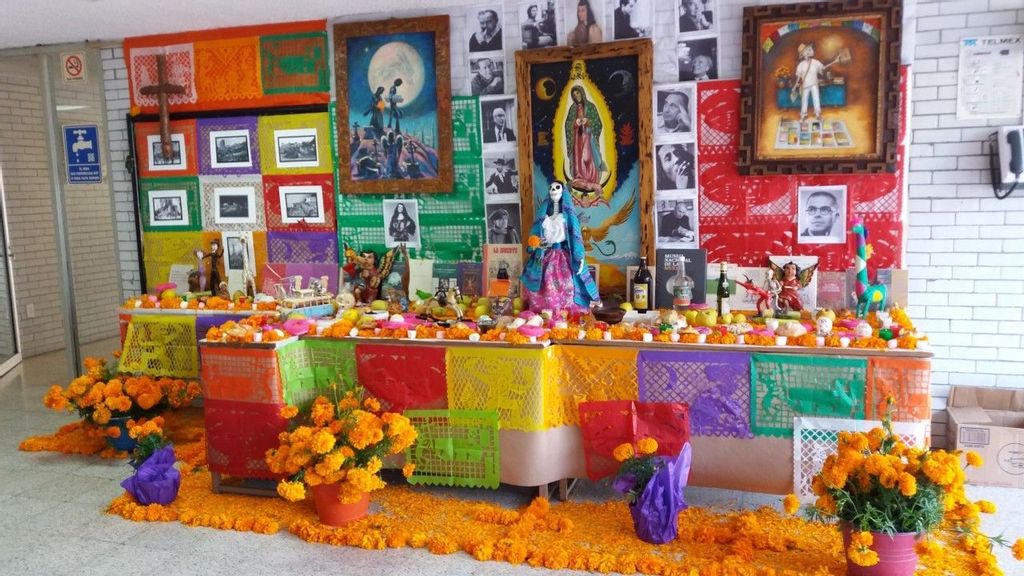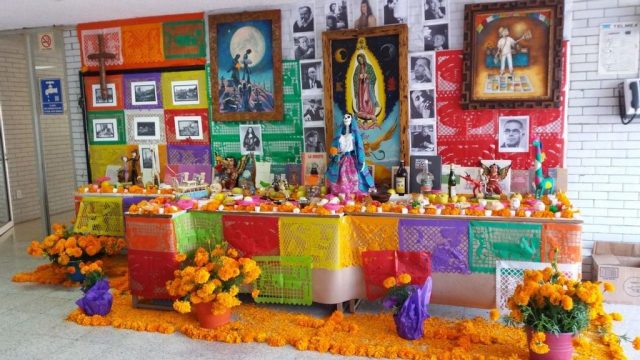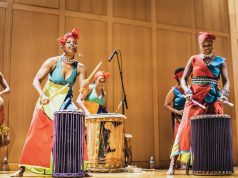
Day of the Dead is a celebration, a ritual and a tradition held on November 1 and 2 that brings together two cultures — the Mexica and the Spanish.
The tradition tends to be distorted outside of Mexico, says Héctor Darío Aguirre, a PhD in Anthropology.
Also, the idea of death in 21st-century Mexico has been influenced by violence and illness, he says.
“In Mexico, death is a friend. Still, with all the violence in the country today and with the global pandemic, we are seeing it differently, although we haven’t lost the idea of continuity,” he says.
“The interesting part is to see how each Mexican celebrates this day, not how foreign films depict it. Not everybody puts an archway on their altar, for example. It symbolizes the entrance to the underworld. The skulls remind us of the tzompantli [stacked skulls found among pre-Hispanic ruins], and the special Day of the Dead sweet bread is a combination of Spanish and Indigenous customs.”

The tradition comes from the Mexica culture, which dominated in Mexico’s central region, what is today Mexico City. When the Spaniards arrived in 1519, a blending of the two cultures ensued that has lasted until today. Some Mexica customs have held on more than others, like this celebration of death, which for that culture is a continuation of life.
“For the Mexicas, human sacrifice to the gods was normal and necessary. It was a privilege to die in that way. Death was not a terrible thing like it was for the Spaniards, but rather a continuation of life … The Spaniards came up with arguments against the idea of creation and continuity … The people learned to see death as something bad, unpleasant or harmful,” says Aguirre.
The original Mexica tradition is based on the belief that souls went to a place determined by how the person died. Most went to Mictlán, on a voyage that lasted four years. On the way, the soul was devoured by Tlaltecuhtli, the Earth goddess.
Then, it traversed 9 descending levels on a painful journey. Finally, when the soul reached Mictlán, a dark, dangerous, unknown place, it offered the gods of death and the underworld the objects with which it had been cremated — grains of corn and beans, other vegetables and precious stones.
“The Mexicas did not set up altars or offerings; they buried people with things. The conquistadors put an end to the human sacrifices and added a Catholic twist to the offering to the gods of death,” says Gabriela Rojas Cruz, whose undergraduate thesis is titled “The Day of the Dead Altar in the Federal District.”

Day of the Dead Altars
Today, Mexicans set up an altar on these days, a modern twist on the ancient custom of burying the dead with the offerings.
“The altar is a sacred place where an offering takes place. Day of the Dead has become a way to make these offerings. So, altar and offering are the same thing,” says Rojas Cruz.
“In many ancient religions it was believed that the spirits would be at peace depending on the offerings of the living. The men from each family worked on these tasks. The altar is usually large, depending on each family’s financial situation, space, and faith,” she says.
Rojas Cruz explains how to make an altar.
“The altar is covered with a white cloth. On the cloth, we place colored tissue paper with perforated designs, which represent death. We place flowers, like the cempasúchil (marigold); also, different types of candles used in religious ceremonies. We add pictures of the deceased who will receive the offerings, a small plate with salt and a glass of water; also, sugar, amaranth or chocolate candy skulls. As an offering, we use seasonal fruits, typical dishes, hot or alcoholic beverages, fruit drinks, and Mexican candies.
“The wax from the candles reminds us that every day that goes by we are being consumed. The flowers are the souls of the dead. They remind us of the beauty and briefness of life. The flame shows the souls the way home. The white cloth is the end of existence,” she said.

Each neighborhood celebrates in its own way.
Mixquic
“In Mixquic, in the southern part of Mexico City, funeral services are transcendental. They believe that a deceased person’s ‘destiny’ depends on the attention given the soul. When the body is placed in the coffin, they add a little water, salt, new huaraches [shoes] and coins, which will help the soul on its voyage through deserts, mountains and mud. The water will quench the soul’s thirst. The salt will keep the flesh from being destroyed. The huaraches are for the thorn-ridden path. The coins are for the dog who will guide the soul,” says Rojas Cruz.
“On November 1 and 2, people from the 4 neighborhoods in the region walk to the cemetery. They clean and fix up the graves. They take flowers, water, incense and liquor. Each person should make an offering to his or her deceased family members. The cemetery comes to life with the different colored flowers, the candlelight, the aroma of incense, the copal [tree resin incense] and tree sap and all the buzz.”

Jaltocán
Laura García, from the town of Jaltocán, in the state of Hidalgo, in the Huasteca region, explains the traditions there.
“For Xantolo [Day of the Dead], we make a hemp archway on a table in each home. We hang flowers, mandarin oranges and clay toys from it. We hang an embroidered cloth on the table, and on that we build the altar.
“At dawn on November 2, we grind the cacao in a metate to make the chocolate. We cook tamales, chicken, turkey or pork in mole sauce [a mixture of spices, chocolate and other ingredients, used on meats], and at dusk we put it on the altar; also, all types of beverages.
“For us, the sweet bread of the dead is a little sugar doll with the hands on its chest, fingers intertwined. We make water bread [a type of roll], mestizo bread, birote [sourdough] and chilindrinas [a sweet bread]. We put it in the center of the table,” she said.

“Each cup of chocolate represents a deceased family member. My sister places one for our mother, her son, my brother-in-law and my husband … The smoke from the incense rising calls the family members: ‘Mother, come for a meal; son, here is your hot chocolate.’ And it feels so good that you start to cry.”
The entire neighborhood takes part in the celebration, which is considered the most important of the year.
“During Xantolo, if someone comes to your home, you give him what is on the altar. It doesn’t matter whether the family knows that person. If you come by the house, you’re invited to eat. We eat at the altar,” García says.
“In the afternoon, the men get dressed up as souls of the deceased. They cover their faces with wooden masks and their heads with handkerchiefs, bandanas and hats. Some put different colored feathers on their heads and bells around their ankles. Others dress up as women. They dance huapangos and banda music. They go from home to home. Before they dance, they ask the homeowners if they will sponsor them. The homeowners give them something to eat and drink and a little money,” García said.


“When the deceased person leaves, we give him his favorite food in a big, new bag made of cord. We thank them and say, ‘Go rest. You have your lunch.’ The bags are white with colored flowers. The deceased leave us on November 3.
“The butterflies that come between September 29 and October 29 are the souls of the deceased. When we see them, we say, ‘Look, a butterfly! Leave it alone. It’s Grandpa, its Uncle … don’t touch it.’ For Jaltocán, butterflies are the souls of our loved ones,” said Laura García.
With these customs, many Mexicans hold on to their roots and consider the death of their loved ones as the other side of life, a continuation, a very different view than the European one. Much of the tradition has been maintained almost intact, despite the cultural blending with the arrival of the Europeans.
Translated by Melanie Slone; edited by Melanie Slone and Kristen Butler
The post Day Of The Dead Brings Pre-Columbian Culture In Mexico Back To Life appeared first on Zenger News.




